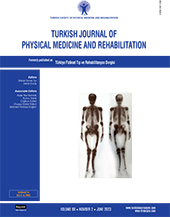Effect of manual lymphatic drainage combined with targeted rehabilitation therapies on the recovery of upper limb function in patients with modified radical mastectomy: A randomized controlled trial
2 Sun Yat-Sen University, Guangdong, China DOI : 10.5606/tftrd.2023.11221 Objectives: This study aimed to evaluate the effect of manual lymphatic drainage (MLD) combined with targeted rehabilitation therapies on the recovery of upper limb function in patients with breast cancer after modified radical mastectomy.
Patients and methods: In the randomized controlled study conducted between October 2019 and June 2020, 104 eligible breast cancer patients who underwent modified radical mastectomy were randomly divided into two groups. The routine functional exercise group (Group RF) received regular functional exercise guidance. In addition, the MLD combined with targeted rehabilitation therapies group (Group MLDT) received MLD, targeted rehabilitation therapies, and regular functional exercise guidance. The primary endpoints were shoulder range of motion, arm circumference and the incidence of axillary web syndrome (AWS). The secondary endpoints included the duration of axillary drainage, the duration of chest wall drainage, and complications.
Results: One hundred participants (mean age: 51.9±8.0 years; range, 28 to 72 years) were included in the final analysis as four patients could not complete the study. A significant improvement in shoulder range of motion was observed in Group MLDT compared to Group RF (p<0.05). Additionally, in Group MLDT, the duration of chest wall drainage was reduced (p=0.037). The frequency of AWS in Group RF was twice that in Group MLDT (p=0.061), but there was no significant difference in arm circumference (p>0.05) or the duration of axillary drainage (p=0.519). Regarding complications, there was one case of necrosis in the MLDT group and four cases in the RF group, including wound infection and seroma.
Conclusion: Manual lymphatic drainage combined with targeted rehabilitation therapies is an effective strategy to improve shoulder function, shorten the duration of chest wall drainage, reduce complications, and partly lower the incidence of AWS.
Keywords : Axillary web syndrome, breast cancer-related lymphedema, breast cancer, shoulder range of motion
















